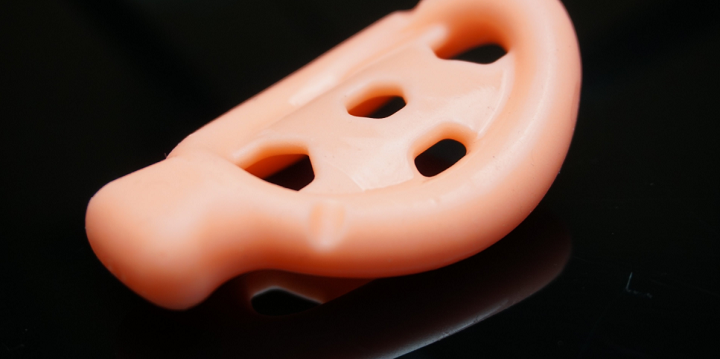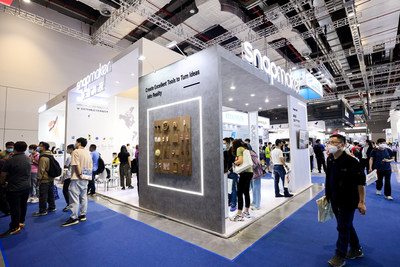We’ve got a lot of research to share with you today, starting with a study on scattering-aware color 3D printing and then a project with the goal of optimizing 3D printed parts for laser welding. Researchers in Germany reviewed multimaterial, multi-photon 3D laser micro- and nano-printing, while a research project in Australia is focused on coatings for space vehicle components. Moving on, a medical device company is using Formlabs technology to create patient-specific pessaries, and TIWARI is printing pure copper with its bound FFF technology. Finally, Snapmaker showcased some of its new AM innovations at TCT Asia, CMS developed a hybrid system for milling and additive manufacturing, and Tinkerine introduced a 3rd party hardware partner program.
Achieving Color-Accurate 3D Print Preparation

We propose a neural scattering compensation for 3D color printing. Comparing to a method which uses noise-free Monte Carlo simulation our technique achieves 300× speedup in the above case while providing the same quality.
A team of researchers from the Computer Graphics Group (CGG) at Charles University in the Czech Republic recently published a paper titled “Neural Acceleration of Scattering-Aware Color 3D Printing” about their new method for improving full-color 3D printing. Their proposal is to predict the subsurface scattering effects that occur within 3D prints by using a model obtained through machine learning, which also speeds up the process. By using this predication, they posit that users can use virtual optimization to compensate for some unwanted color effects by rearranging the materials inside an object.
The abstract states, “With the wider availability of full-color 3D printers, color-accurate 3D-print preparation has received increased attention. A key challenge lies in the inherent translucency of commonly used print materials that blurs out details of the color texture. Previous work tries to compensate for these scattering effects through strategic assignment of colored primary materials to printer voxels. To date, the highest-quality approach uses iterative optimization that relies on computationally expensive Monte Carlo light transport simulation to predict the surface appearance from subsurface scattering within a given print material distribution; that optimization, however, takes in the order of days on a single machine. In our work, we dramatically speed up the process by replacing the light transport simulation with a data-driven approach. Leveraging a deep neural network to predict the scattering within a highly heterogeneous medium, our method performs around two orders of magnitude faster than Monte Carlo rendering while yielding optimization results of similar quality level. The network is based on an established method from atmospheric cloud rendering, adapted to our domain and extended by a physically motivated weight sharing scheme that substantially reduces the network size. We analyze its performance in an end-to-end print preparation pipeline and compare quality and runtime to alternative approaches, and demonstrate its generalization to unseen geometry and material values. This for the first time enables full heterogenous material optimization for 3D-print preparation within time frames in the order of the actual printing time.”
Optimizing 3D Printed Parts for Laser Welding
Scientists from Germany’s Institute for Integrated Production Hannover and Laser Zentrum Hannover (LZH) are working together on a research project with the end goal of welding 3D printed components using a laser. The project is called QualLa, which stands for “Quality assurance in laser welding of additively manufactured thermoplastic components,” and the scientists are partnering up in order to develop an expert system that’s capable of supporting small and medium-sized enterprises in the optimization of 3D printing processes—specifically FDM—so that a laser can be used to securely weld 3D printed parts together. Laser welding is often used for plastic injection molded components, but the team explained that this type of joining doesn’t typically work with AM because the cavities and boundary layers in the components aren’t conducive to a uniform weld; that’s why they’re working to develop an expert system for the task, which could provide recommendations on which layer orientation, thickness, and material are best suited for the highest possible permeability for the laser beam.
“Due to the way the layer-by-layer structure is used in components that are manufactured using FDM, there are local changes in the transmission of the laser through the transparent joining partner. As a result, the joining process has to be controlled locally depending on the degree of transmission,” the researchers explained.
“The aim of the QualLa research project is to develop a process that enables laser transmission welding of components manufactured using FDM. Since the development of process knowledge can pose challenges to small and medium-sized enterprises (SMEs) due to financial and personnel limitations, an expert system for process support is to be developed as part of the project. In the expert system, the necessary specialist knowledge is to be recorded in order to allow a quality-assuring use, so that the employees in SMEs can use the technology without complete knowledge of the process technology.”
Review of Multimaterial 3D Micro- and Nano-Printing

Multimaterial 3D microarchitectures for applications in optics and photonics. (a) Left: Scheme of a 3D deterministic fluorescent security feature containing four different doped polymers emitting at four different wavelengths (red, blue, green, and yellow) and one non-fluorescent polymer component. Right: Measured fluorescence stack, obtained from ref. 105. (b) Colored electron micrograph. A microoptical lens composed of two different polymers (blue and green) has directly been 3D printed onto the end facet of a single-mode optical fiber (red), obtained from ref. 115. (c) Polymer waveguide on a substrate and ring liquid-crystal elastomer optical ring cavity. By stimuli such as temperature and light, the liquid-crystal elastomer swells/contracts, allowing for tuning the coupling between waveguide and resonator, obtained from ref. 116.
A review of multimaterial, multi-photon 3D printing at the micro- and nano-scale was completed by researchers from Karlsruhe Institute of Technology (KIT) and Ruprecht Karl University of Heidelberg, also known as Heidelberg University, in Germany, and their unedited, peer-reviewed manuscript was accepted for publication by the journal Light: Advanced Manufacturing. While they stayed away from 3D metamaterials or “meta-inks,” the team did focus on recent multi-photon approaches which have had quick development processes, such as two-photon absorption. They also review existing materials that could serve as a working set of “primary materials.”
“Three-dimensional (3D) laser micro- and nanoprinting based upon multi-photon absorption has made its way from early scientific discovery to industrial manufacturing processes, e.g., for advanced microoptical components. However, so far, most realized 3D architectures are composed of only a single polymeric material,” the abstract states. “Here, we review 3D printing of multi-materials on the nano- and microscale. We start with material properties that have been realized, using multi-photon photoresists. Printed materials include bulk polymers, conductive polymers, metals, nanoporous polymers, silica glass, chalcogenide glasses, inorganic single crystals, natural polymers, stimuli-responsive materials, and polymer composites. Next, we review manual and automated processes achieving dissimilar material properties in a single 3D structure by sequentially photoexposing multiple photoresists as 3D analogs of 2D multicolor printing. Instructive examples from biology, optics, mechanics, and electronics are discussed. An emerging approach – without counterpart in 2D graphical printing – prints 3D structures combining dissimilar material properties in one 3D structure by using only a single photoresist. A controlled stimulus applied during the 3D printing process defines and determines material properties on the voxel level. Change of laser power and/or wavelength, or application of quasi-static electric fields allow for the seamless manipulation of desired materials properties.”
Coating for Space Vehicle Components
Moving to Australia next, researchers from Swinburne University of Technology and Melbourne-based metal AM specialist Amaero International, along with the Australian National Fabrication Facility, are working on a project regarding coatings for space vehicle engine components. Their collective goal is to advance what they describe as “Compliant Multilayer Environmental Barrier Coatings (EBCs)” by developing coatings for internal turbine engine nozzles and surfaces. Amaero, a Monash University spinout with experience in the automotive, aerospace, and defense industries, will provide $150,000 in funding (excluding GST) over 48 months to support two PhD students and direct project costs, as well as an additional $150,000 of value in-kind, including technical advice, designs, and 3D printed demonstrator parts.
Amaero CEO Barrie Finnin stated, “The global space industry represents a significant large and strategic commercial opportunity for Amaero and this research will enhance the industry leading technology that our company provides.”
3D Printed Patient-Specific Pessaries
According to an NIH-funded study, nearly one-quarter of all women suffer from pelvic floor disorders (PFDs), and this frequency goes up with age. With symptoms like fecal and urinary incontinence and pelvic organ prolapse, these disorders happen when the hammock, or sling, supporting the pelvic organs is damaged or becomes weak, and unfortunately, there’s a lot of stigma involved. An effective tool in managing and treating these disorders is a supportive prosthetic inserted into the vagina called a pessary, but with standard sizing, women suffer further discomfort because trial and error is the only way to find one that fits well. In 2017, Derek Sham, who’d watched his grandmother go through a severe prolapse, founded medical device company Cosm in order to create patient-specific pessaries for people suffering from pelvic floor disorders. The company uses ultrasounds, cloud software, machine learning and 3D printing in its unique digital workflow, called Gynethotics, in order to address this very specific gap in women’s healthcare, and partnered with Formlabs, using its Form 2 and later the Form 3B, after reading a whitepaper on the 3D printing unicorn‘s custom silicone ear molds and realizing the technology could be applied to one-part cocoon molds for its patient-specific pessaries.
“[PFD is] quite common in women, but it’s not widely talked about. It was certainly not something I was aware of when I was pregnant with my kids. We wanted to promote awareness and promote treatment because it could be that options for treatment could be physiotherapy. If you have early-stage prolapse, ultimately you could also do surgery but surgery is associated with complications and a relatively high repeat rate of needing another surgery later on. We hope that the pessary usage could help women deal with prolapse for a longer period of time and could improve their pessary refitting success,” explained Cosm’s Chief Cosm Technology Officer Aye Nyein San.
“After scouring the world’s leading 3D printing companies, we knew that direct printing was currently not possible to the quality we needed for our production. From reading various Formlabs white papers, we tested the cocoon molding process, which is a full mold instead of a clamshell mold, which will have a parting line that we didn’t want to have that kind of artifact in the device. So we are using the Formlabs printer to print the mold only, and we are injecting the biocompatible silicone as part of that process.”
TIWARI Adds Pure Copper to FFF Materials Portfolio
Hardware-oriented startup TIWARI Scientific Instruments, which is supported by the European Space Agency (ESA), has added a new material to its portfolio, with its recent success in printing complex geometries using pure copper on its RAPTOR bound FFF 3D printer. Some of the oxygen-free, high-density copper parts the startup printed include high-resolution heat exchangers, which TIWARI designed using nTopology software and manually optimized for performance.
Because of the material’s high thermal conductivity, pure copper has high potential for 3D printing heat exchangers, but it’s not easy to process as a filament or powder. TIWARI’s EAM technology uses specially fabricated bound ceramic or metal filaments—like stainless steel, titanium, silicone carbide, and Zirconia —which are shaped via its in-house FFF 3D printers, and these “green parts” are later machined if further details and better surface finish are required, before they’re heat-treated to get rid of the binder and sinter the part. These parts can also be polished manually in this green state, which helps decrease post-processing costs.
Snapmaker Showed Off AM Innovations at TCT Asia
TCT Asia 2021 was held in Shanghai last month, and Snapmaker was on hand to show off its latest 3D printing solutions, like the new Snapmaker 2.0 Rotary Module. The company is unique as a TCT exhibitor, as it combines both additive and subtractive manufacturing, and its 3-in-1 modular system uses 3D printing, CNC carving, and laser engraving and cutting. The Rotary Module, an attachment that’s compatible with Snapmaker 2.0 A250 and A350, was actually launched at the end of 2020, so this was the first time it was publicly seen in China. The product allows for desktop 4-axic CNC, and features a strain wave gearing, 100:1 speed reducer, and supports 0.2° precise control as well as 360° 5-degree continuous rotation. The Rotary Module should be a good solution for middle to advanced DIY makers, technical engineers, and 3D model designers.
“I’m glad to notice that more users are getting to know 3D printing this year. The applications of 3D printing can actually help individuals and enterprises to solve real problems. As a 3D printer manufacturer, Snapmaker will establish strong relationships with users, service provider, and distributors to promote the consumerization of 3D printing,” said Ke Shuqiang, the CFO and COO at Snapmaker.
CMC & Fraunhofer Institute Unveil Hybrid LFAM Solution
Since 2018, CNC machine leader CMS Advanced Materials Technology has been working with the Fraunhofer Institute to create an original large-format additive manufacturing (LFAM) solution to improve the competitiveness of composite and other industries, and the hybrid milling/AM system, called the CMS Kreator, is finally here. The unique system was designed to totally integrate an LFAM printer and a machine tool, while also delivering less manufacturing times, subparts, and costs than typical large-scale FDM printing.
Featuring a patented single screw extruder for fabricating different materials with its Screw Extrusion Additive Manufacturing (SEAM) technology, CMS says its Kreator boasts a mass flow of up to 7 kg/h, with 20 k/g on its way. The Kreator is said to use up to five times less material than its competitors to fabricate the same part. Speaking of material, the system has been tested with PA, PP, PET, ABS, and others reinforced with carbon fiber and glass. You can learn more in the video below:
Tinkerine’s 3rd Party Hardware Partner Program
Canadian company Tinkerine Studios Ltd, which offers 3D printing products and educational resources, just introduced its 3rd party hardware partner program, which is meant to grow the amount of compatible 3D printer hardware that Tinkerine Cloud will support. The company’s Cloud, which is based on years of collected Tinkerine customer data, basically streamlines the workflow for FFF 3D printer operators by decreasing the number of steps required to print, and then manage the prints. Tinkerine can now increase Cloud’s immediate user base by supporting the integration of expanded hardware choices, and then servicing and scaling the business, regardless of brand. The company is encouraging 3D printing companies around the world to participate in its new program, so more customers can access its easy to use yet powerful software.
“3rd party hardware expansion with Tinkerine Cloud is an important step to scale and expand our products and provide a positive impact for customers, At Tinkerine, we’re focused on ensuring our products and services are user friendly and simplify their workflow. Our platforms are designed based on Tinkerine’s hardware products and customers of today and tomorrow can expect the same level of integration for any partner’s hardware in this program,” said Eugene Suyu, Tinkerine CEO and Co-Founder.
Subscribe to Our Email Newsletter
Stay up-to-date on all the latest news from the 3D printing industry and receive information and offers from third party vendors.
You May Also Like
3D Printing News Unpeeled: A $3000 SLS System, Construction Subsidies and Parameters
The Housing Affordability Crisis is one of Canadian President Trudeau’s biggest issues. Now the government has made subsidies available, including scaling new technologies, 3D printed housing and libraries of reapproved...
“Bundled Light” Enables High Quality Plastic 3D Printing from LEAM
Naturally, we expect current 3D printing methods to continuously improve, but it continues to do so in the most surprising ways. The latest development comes from LEAM, a startup spun...
Each to Their Own: Exploring Creality’s Latest Ender Trio as the Company Strengthens Its Commitment to 3D Printing Advocacy
Creality has reaffirmed its commitment to promoting 3D printing. The launch of the Ender-3 V3 SE, Ender-3 V3 KE, and Ender-3 V3 showcases the company’s dedication to catering to diverse...
3D Printing News Briefs, March 23, 2024: AM in the US Coast Guard, Navy, & More
In today’s 3D Printing News Briefs, we’re discussing the use of 3D printing in various branches of the military, including the U.S. Coast Guard, the U.S. Navy, and the German...






































